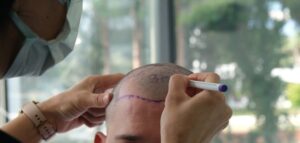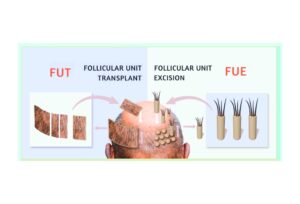Because our hair is such a prominent feature, hair loss can have a profound effect on our self-esteem. Many people feel their hair loss makes them appear less attractive, youthful, vital and desirable. Some may struggle to find a romantic partner, or to get hired for a new job – even if they are the best candidate.
For anyone who is seeking solutions to hair loss, hair restoration is a natural topic to research. However, those with severe baldness – the most devastating degree of hair loss – have not been candidates for hair restoration until very recently. Fortunately, new techniques now allow the extraction of beard and body hair as an additional graft resource for patients who no longer have enough head hair follicles to use as a donor site.

Hair Restoration Using Beard and Body Hair Follicles
Beard and body hair can provide an entirely new source of hairs that can number in the thousands, permitting further coverage than experts once thought possible. The best areas for harvesting these donor hairs are the beard, followed by the chest and back.
While hair growth in the beard tends to be relatively similar to that of the scalp, hair growth in the chest and back is typically shorter in most patients. However, once transplanted into the scalp, these hairs will typically take on characteristics similar to scalp hair regarding both their texture and their ability to integrate seamlessly into the scalp and grow long, as if they were always on the scalp.
The significant innovation of being able to harvest beard and body hair follicles from donor sites is based on the technique of follicular unit extraction, or FUE. Depending upon the desired density and the size of the areas to be covered, one FUE procedure can extract from 500 to as many as 4,000 body hair grafts.
FUE allows hairs to be transplanted one by one, with precise attention given to the exact placement and direction of each hair. FUE is the most natural and sophisticated hair restoration method available today, and has gained rapid acceptance among professionals and patients alike because it is minimally invasive, highly versatile and leaves little detectable scarring.
Not only is FUE quicker and less painful than any other hair restoration technique, but it also offers visible results in hair density levels after just one session – all with no incisions, sutures or staples.
A surgeon skilled in FUE uses a small, handheld punch to excise small groupings of one to four beard and body hair follicles, which then get reinserted into receptor sites on the top and sides of the head. The surgeon removes the grafts in a widespread pattern that minimizes the appearance of scars and avoids leaving any bald patches.

Who Is a Good Candidate for Beard and Body Hair Procedures?
Previously, patients with the most severe cases of baldness were the only ones who did not qualify for hair transplantation techniques, since patients with excessive hair loss lack the scalp donor hair to perform a successful hair transplant procedure.
Harvesting beard and body hair benefits the patients who need hair restoration surgery more than anyone else. Now, this advanced FUE technique is helping thousands of patients regain their self-esteem and quality of life.
For most patients who lack the required quantity of scalp donor hair, beard and body hair is an outstanding alternative resource. On average, it has an excellent long-term graft survival rate, and is thick enough to provide a desirable coverage and density.
The best candidates have a sufficient quantity of beard or body hair to serve as their donor supply, are over the age of 24 and have no medical history of allergies to anesthesia, irregularities with blood clotting or easy scarring tendencies.
In addition to the severely bald, other patients with massive scarring and minimal donor hair on their scalp may benefit from using beard and body hair as an effective hair restoration source. These include patients who have previously received a failed hair restoration surgery, as well as victims of a burn or other injury. Using beard and body hair as the donor sites allows FUE practitioners to complete an otherwise impossible hair restoration surgery.
How to Find a Good Hair Restoration Surgeon
When it comes to your hair restoration, the most important decision you have to make is what physician to select. It’s vital to do your research and choose your physician wisely. After all, who you choose to work with will determine the appearance of your hair for the rest of your life.
Dr. Robert Jones founded the Toronto Hair Restoration Center to provide patients with the latest innovations in hair transplants. Our patient-focused practice is solely dedicated to the art and science of surgical hair restoration techniques. As a physician dedicated to full-time hair transplants, Dr. Jones provides a high level of attention to detail and a truly superior hair restoration experience.
Dr. Jones has been performing FUE hair transplants since 2003, and was the first doctor in the world to perform large sessions using this technique. He regularly performs 3,000 to 4,000-graft FUE cases in a single day, and is personally involved in every surgery he performs from beginning to end.
As an expert in hair restoration surgical techniques, Dr. Jones is a member of the International Society of Hair Restoration Surgery, and has been practicing medicine since 1979. Throughout his career, he has treated thousands of patients not only from Canada, but from Europe, Asia, Australia, Africa, South America and the rest of North America. Dr. Jones provides all his patients with the gold standard of hair restoration: an undetectable, natural and totally seamless look.
View our before-and-after hair transplant photo gallery to see pictures of the superior results of real patients who have benefited from the innovative techniques we offer.
Are you ready to change your life with natural-looking hair restoration? Contact our clinic today to schedule a complimentary, confidential consultation with Dr. Jones.

















